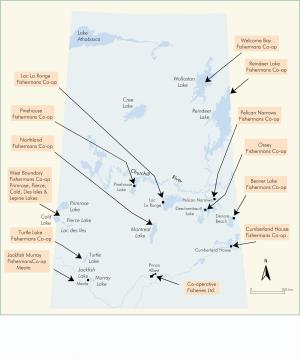
Northern Saskatchewan has the third largest concentration of Aboriginal Co-operatives in Canada after the Northwest Territories/Nunavut and Nunavik in northern Quebec. Most are survivors of the extensive program of northern co-operative development undertaken by the Saskatchewan CCF government during the 1950s and 1960s. The first northern co-operative in Saskatchewan was the fishers' co-op at Kinoosao on Reindeer Lake, incorporated in 1945; the number of Co-operatives grew to a high of 62 in 1971. In 1969 there were 57 co-operatives, including 18 local fishers' co-operatives and a central fish marketing co-operative, 15 local retail stores and a central consumer co-operative, 2 credit unions, and co-operatives for electric power, wood products, recreation, handicrafts and fur production. They had 4,900 members, and represented $2.5 million in annual sales and services. In 2003 there were 25 co-operatives reported, including 9 fishers' co-operatives, 4 retail (store) co-operatives, and 2 credit unions. Pinehouse, a Métis settlement, has a successful co-operative store and a fishers' co-operative; Stanley Mission is one of several First Nations settlements with co-operative stores.
Many of the northern co-operatives grew out of two northern Crown Corporations formed in 1949: the Saskatchewan Fish Marketing Service, which purchased and marketed fish; and Saskatchewan Government Trading, which sold equipment and supplies to fishers. Whereas the Crown corporations succeeded in involving northern people in the commercial fishing industry, co-operatives were intended to involve them in business decision-making. So the two northern Crowns were transformed in 1959 into two convertible corporations. Initially placed under one government-appointed central board of southern co-operative leaders, they were intended to become true co-operatives as soon as the members were ready to own and operate them. The Saskatchewan Fish Marketing Service became Co-operative Fisheries Limited (CFL), initially with 12 local fishers' co-operatives, fish processing plants, and other assets (see Figure CN-1). In 1966 the $225,000 debt to the provincial government for the assets transferred was repaid in full, and in 1971 CFL became a true co-operative.
Similarly, Saskatchewan Government Trading transferred its six trading stores and other assets to Northern Co-operative Trading Services Limited (NCTSL). Co-operatives with local boards of directors were formed. By 1966, two-thirds of the initial $275,000 debt had been repaid and two stores had paid their debts in full. NCTSL was dissolved in 1978. A key element in establishing and supporting new northern co-operatives through the 1960s was co-operative management advisors, who worked in the north both to oversee the economic aspects and to help the people learn the skills needed to manage and control their own businesses. Also important were a “learn by doing” approach and a strong educational component at membership and board meetings. The impact of northern co-operatives was both economically and socially significant, particularly with Aboriginal people, and greatly contributed to developing skills in leadership and decision-making. (See also Co-operatives; Co-operatives, Other)
Daniel M. Beveridge
Print EntryHOME | BROWSE BY SUBJECT | ENTRY LIST (A-Z) | IMAGE INDEX | CONTRIBUTOR INDEX | ABOUT THE ENCYCLOPEDIA | SPONSORS TERMS OF USE | COPYRIGHT © 2006 CANADIAN PLAINS RESEARCH CENTER, UNIVERSITY OF REGINA | POWERED BY MERCURY CMS |
|||
| This web site was produced with financial assistance provided by Western Economic Diversification Canada and the Government of Saskatchewan. |
|||
 |
 |
 |
 |
| Ce site Web a été conçu grâce à l'aide financière de Diversification de l'économie de l'Ouest Canada et le gouvernement de la Saskatchewan. |
|||